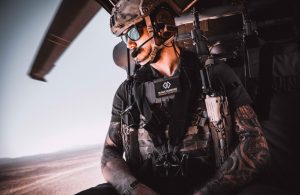The Future of Dismounted Generic Soldier Architecture.
Dismounted generic soldier architecture has up until now been based around the USB 2.0 standards – the US Nett Warrior Program used a Mighty Mouse 6-pin connector that provided power and data to that standard. With the US military making developments in Next Generation Radio technology (see Precision Technic Defence Focus: Next Generation
Hand-Held Radios article) and an ever- increasing power requirement, there is a need for the standard to be reviewed.

With these increased power demands the dismounted operator is required to simultaneously power multiple devices as well as provide the option to charge individual items or the system, through the utilisation of a central battery.
The demands on the system already exceed the power capability of the old standard cabling and the connector with only 5 Amps of power being able to be drawn by the system. This will not be viable with the next generation of radios and devices being carried by the soldier and will lead to choke points in the system which results in power brown outs. Soldier power and data architecture that supports USB 3.1 and higher power transfer can provide a system power of up to 15 Amps.
An increase in data transfer through the dismounted system does not currently exceed the maximum rate for a USB 2.0 standard. However, the use of USB 3.1 standard allows for increased power management through USB Power Delivery, allows for more efficient routing of data and allows for the ability to operate USB Type-C end user devices (EUD) that cannot perform in as a system host whilst simultaneously charging the EUD.
It is common when dealing with military programs, to procure equipment that needs to be in service for 5-10 years. Focusing on procurement of last generation standard equipment will not allow for the technology refresh throughout the life of a program when higher data rate and power consumption peripherals and radios are introduced. By procuring last generation soldier architecture, any “future soldier” programs will be hamstrung.
While USB 2.0 connectivity is one of our current offerings, Precision Technic Defence have, for many years, worked with our partners to mitigate the issues of higher power and data demand on the dismounted architecture with USB 3.1 compatible systems already being delivered into major US, Australian and European programs. The connectors used in line with this standard greatly increase the power availability to the peripheral and provides increased data transfer rates to help in “future proofing” any deployed dismounted capability.
News article no. 2/2020

